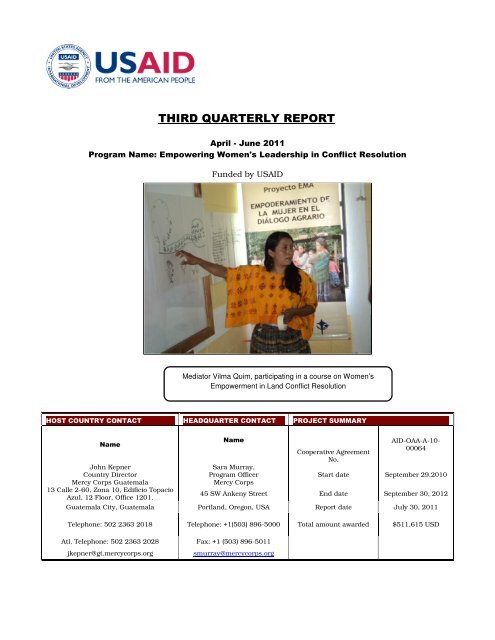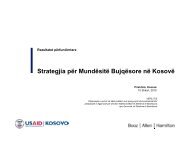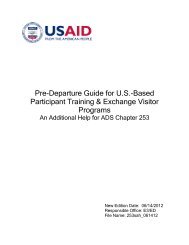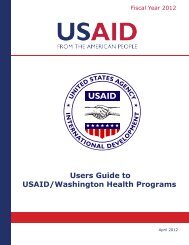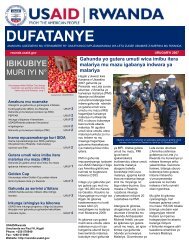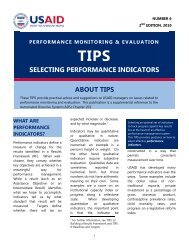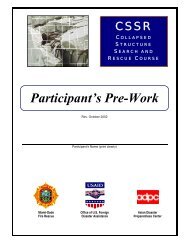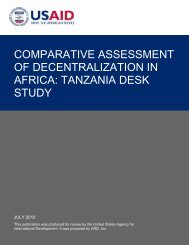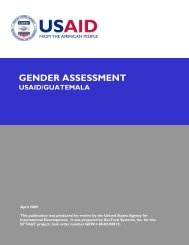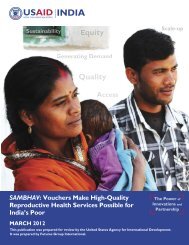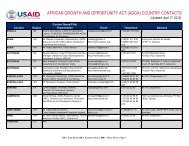Empowering Women's Leadership in Conflict Resolution: Third ...
Empowering Women's Leadership in Conflict Resolution: Third ...
Empowering Women's Leadership in Conflict Resolution: Third ...
Create successful ePaper yourself
Turn your PDF publications into a flip-book with our unique Google optimized e-Paper software.
THIRD QUARTERLY REPORT<br />
April June 2011<br />
Program Name: <strong>Empower<strong>in</strong>g</strong> <strong>Women's</strong> <strong>Leadership</strong> <strong>in</strong> <strong>Conflict</strong> <strong>Resolution</strong><br />
Funded by USAID<br />
Mediator Vilma Quim, participat<strong>in</strong>g <strong>in</strong> a course on Women’s<br />
Empowerment <strong>in</strong> Land <strong>Conflict</strong> <strong>Resolution</strong><br />
HOST COUNTRY CONTACT HEADQUARTER CONTACT PROJECT SUMMARY<br />
Name<br />
John Kepner<br />
Country Director<br />
Mercy Corps Guatemala<br />
13 Calle 2-60, Zona 10, Edificio Topacio<br />
Azul, 12 Floor, Office 1201.<br />
Guatemala City, Guatemala<br />
Telephone: 502 2363 2018<br />
Atl. Telephone: 502 2363 2028<br />
jkepner@gt.mercycorps.org<br />
Name<br />
Sara Murray,<br />
Program Officer<br />
Mercy Corps<br />
45 SW Ankeny Street<br />
Portland, Oregon, USA<br />
Telephone: +1(503) 896-5000<br />
Fax: +1 (503) 896-5011<br />
smurray@mercycorps.org<br />
Cooperative Agreement<br />
No.<br />
Start date<br />
End date<br />
Report date<br />
Total amount awarded<br />
AID-OAA-A-10<br />
00064<br />
September 29,2010<br />
September 30, 2012<br />
July 30, 2011<br />
$511,615 USD
ACRONYMS<br />
AOP Annual Operat<strong>in</strong>g Plan<br />
APROBASANK Pro-Bienestar en Acción Association<br />
CMF Community Mediation Facilitator<br />
COCODE Community Development Councils<br />
COMUDE Municipal Development Councils<br />
DEMI Public Defender’s Office for Indigenous Women<br />
EMA <strong>Empower<strong>in</strong>g</strong> Women’s <strong>Leadership</strong> <strong>in</strong> <strong>Conflict</strong> <strong>Resolution</strong><br />
FONTIERRA Land Fund<br />
GTZ German Agency for Technical Cooperation<br />
JADE Association of Jurists for Legal Development<br />
ADR Alternative Dispute <strong>Resolution</strong><br />
MARN M<strong>in</strong>istry of the Environment and Natural Resources<br />
MDP Municipal Development Plan<br />
MOW Municipal Office for Women<br />
MPO Municipal Plann<strong>in</strong>g Office<br />
MS Mediation Specialists<br />
OMM Ofic<strong>in</strong>a Municipal de la Mujer (Municipal office for Gender)<br />
PROCAR Rural Tra<strong>in</strong><strong>in</strong>g Program<br />
RIC Registry of Cadastral Information<br />
SAA Secretariat for Agrarian Affairs<br />
SEGEPLAN Presidential Plann<strong>in</strong>g Secretariat<br />
SEPREM Presidential Secretariat for Women<br />
ToR Terms of Reference<br />
TT Tra<strong>in</strong> the tra<strong>in</strong>er approach<br />
<strong>Empower<strong>in</strong>g</strong> <strong>Women's</strong> <strong>Leadership</strong> <strong>in</strong> <strong>Conflict</strong> <strong>Resolution</strong><br />
2
I. EXECUTIVE SUMMARY<br />
Activities dur<strong>in</strong>g the third quarter of the <strong>Empower<strong>in</strong>g</strong> Women’s <strong>Leadership</strong> <strong>in</strong> <strong>Conflict</strong> <strong>Resolution</strong><br />
(referred to as EMA, by its acronym <strong>in</strong> Spanish), resulted <strong>in</strong> the follow<strong>in</strong>g accomplishments:<br />
• Eight women were tra<strong>in</strong>ed and certified as mediators of land conflicts;<br />
• A conflict mediation handbook, titled the “Basic handbook for equitable land conflict<br />
mediation <strong>in</strong> Alta Verapaz” was drafted by project members;<br />
• Community facilitators were tra<strong>in</strong>ed on alternative dispute resolution;<br />
• A public awareness campaign on women’s agrarian rights was launched, <strong>in</strong>clud<strong>in</strong>g<br />
radio public service announcements, and<br />
• A variety of civil society organizations and governmental actors worked together to<br />
improve women’s access to land and agrarian rights.<br />
The project’s tra<strong>in</strong><strong>in</strong>g activities this quarter focused on empower<strong>in</strong>g women and build<strong>in</strong>g their capacity<br />
to participate <strong>in</strong> public spaces at both the community and municipal levels. This tra<strong>in</strong><strong>in</strong>g process is<br />
complemented and fortified by the public awareness campaign that re<strong>in</strong>forces themes on women’s<br />
rights and conflict resolution.<br />
The engagement and active participation of the Community Development Councils (COCODES) <strong>in</strong> the<br />
project lends additional strength to project activities, and allows active land conflicts to be brought to<br />
the attention of EMA mediators, allow<strong>in</strong>g female mediators to attend to and help resolve these<br />
disputes.<br />
The project coord<strong>in</strong>ated with SEPREM (the Presidential Secretariat for Women), DEMI (the Public<br />
Defender’s Office for Indigenous Women), and other key local actors to hold a municipal level<br />
workshop entitled “Incorporat<strong>in</strong>g Land <strong>Conflict</strong> Considerations <strong>in</strong>to the Natural Resource, Land and<br />
Hous<strong>in</strong>g Pillars of the National Policy for the Promotion and Integral Development of Women”. This<br />
workshop set the strategy to <strong>in</strong>tegrate the national policy for the promotion of gender <strong>in</strong>tegrated rural<br />
development together with the law of land use plann<strong>in</strong>g with<strong>in</strong> the framework of Municipal<br />
Development Plans (MDP).<br />
Ma<strong>in</strong> project activities scheduled for the next quarter are as follows: a) identify and prioritize land<br />
conflict cases; b) draft a strategy to address land conflicts, tak<strong>in</strong>g <strong>in</strong>to account gender, and design of<br />
an <strong>in</strong>formation system for collection and analysis of data and result of project activities; c) follow up on<br />
public awareness campaigns that <strong>in</strong>cludes radio programs, posters and community murals; d) follow<br />
up on the awareness build<strong>in</strong>g process of key actors with events such as: tra<strong>in</strong><strong>in</strong>g COCODES on<br />
equitable negotiation processes, talk shows with media and religious leaders, and meet<strong>in</strong>gs with youth<br />
from conflict areas; e) <strong>in</strong>itiation of the first stage of a diploma course for representatives of local<br />
organizations on formulation and monitor<strong>in</strong>g for gender equity <strong>in</strong> municipal agrarian policies; f)<br />
tra<strong>in</strong><strong>in</strong>g of coord<strong>in</strong>ators on <strong>in</strong>ternational norms for women’s rights, especially <strong>in</strong> the areas of agrarian<br />
issues and advocacy, to further assert women’s rights <strong>in</strong> agrarian issues g) formulation of a strategy to<br />
create a system for the equitable management of municipal agrarian policies; h) cont<strong>in</strong>uation of the<br />
capacity build<strong>in</strong>g process for the local partner FUNDEMI regard<strong>in</strong>g land conflict management; and i)<br />
cont<strong>in</strong>uation of tra<strong>in</strong><strong>in</strong>g mediators on processes for regulariz<strong>in</strong>g state property cases facilitated by<br />
partner organizations.<br />
<strong>Empower<strong>in</strong>g</strong> <strong>Women's</strong> <strong>Leadership</strong> <strong>in</strong> <strong>Conflict</strong> <strong>Resolution</strong><br />
3
II. Implementation Summary<br />
Regional context:<br />
The municipalities currently served by the EMA project displayed the follow<strong>in</strong>g political, environmental<br />
and cultural dynamics this quarter:<br />
• Political rally<strong>in</strong>g for the upcom<strong>in</strong>g elections is <strong>in</strong>tensify<strong>in</strong>g, and the population is beg<strong>in</strong>n<strong>in</strong>g to<br />
take sides by jo<strong>in</strong><strong>in</strong>g different political parties and civic committees. This situation divides the<br />
population and has a significant impact on social relations. Municipal authorities and staff<br />
encourage and actively participate <strong>in</strong> rally<strong>in</strong>g, thereby neglect<strong>in</strong>g their responsibilities and<br />
tasks. The current political <strong>in</strong>stability reaches as far as state officials, who fear that a change <strong>in</strong><br />
adm<strong>in</strong>istration could affect their cont<strong>in</strong>ued employment as public officials. As a result, there is<br />
marked dis<strong>in</strong>terest and a current lack of enthusiasm among public officials <strong>in</strong> participat<strong>in</strong>g <strong>in</strong><br />
EMA activities.<br />
• The economic crisis affect<strong>in</strong>g communities has compelled them to turn to alternate survival<br />
strategies, such as reduc<strong>in</strong>g food expenditures and <strong>in</strong>creas<strong>in</strong>g their political demands for a<br />
solution to their current crisis through roadblocks and other demonstrations.<br />
• Several community members were heavily <strong>in</strong>volved <strong>in</strong> agricultural labor from April through<br />
•<br />
June, and consequently participated less <strong>in</strong> the project’s tra<strong>in</strong><strong>in</strong>g sessions.<br />
Regard<strong>in</strong>g land conflict issues, there is a lot of mis<strong>in</strong>formation provided by <strong>in</strong>stitutions about<br />
procedures to legalize land tenure or resolve conflicts. As a result, the public is distrustful of<br />
the government as a result of previous deceptions and fees charged by public officers who<br />
mishandled their cases.<br />
Implementation by Objectives<br />
Objective 1<br />
Geographical Areas<br />
Sub - Sector:<br />
INDICATORS<br />
1.1. % of mediators apply<strong>in</strong>g gender <strong>in</strong>clusive<br />
approaches to ADR<br />
Indigenous women negotiate and mediate peaceful resolution of agrarian conflicts<br />
Fray Bartolomé de las Casas, Raxruhá, Chisec, and Cobán, Alta Verapaz<br />
BASE LINE<br />
7%<br />
16%**<br />
GOAL<br />
100%<br />
100% <strong>in</strong>crease<br />
PROGRESS<br />
(quarter)<br />
-<br />
PROGRESS<br />
(cumulative)<br />
1.2. % change <strong>in</strong> number of negotiated<br />
agreements reflect<strong>in</strong>g gender considerations<br />
(6 agreements) (no less than 12<br />
agreements)<br />
-<br />
-<br />
1.3.a Number of tra<strong>in</strong>ed people <strong>in</strong> conflict<br />
mitigation and resolution skills<br />
In progress 100%<br />
12<br />
12<br />
1.3.b Number and percentage of women<br />
mediators<br />
0% 8 8 8<br />
1.3.c Number and % of agrarian conflicts<br />
mediated by <strong>in</strong>digenous women<br />
0<br />
20 cases<br />
-<br />
-<br />
1.4.a % change <strong>in</strong> number of women’s<br />
0%<br />
25%<br />
parties negotiat<strong>in</strong>g agreements on agrarian<br />
issues<br />
-<br />
-<br />
1.4.b Number of people reached by advocacy<br />
campaigns for land conflict resolution.<br />
In progress 5000<br />
-<br />
-<br />
**Note: Note <strong>in</strong>dicator 1.2, at 16%, <strong>in</strong>stead of 23% reported the previous quarter. This change resulted from a review of the basel<strong>in</strong>e study, which was <strong>in</strong><br />
draft form at the time of the last report.<br />
<strong>Empower<strong>in</strong>g</strong> <strong>Women's</strong> <strong>Leadership</strong> <strong>in</strong> <strong>Conflict</strong> <strong>Resolution</strong><br />
4<br />
-
1.<br />
2.<br />
3.<br />
4.<br />
5.<br />
6.<br />
Eight EMA Project mediators were certified after participat<strong>in</strong>g <strong>in</strong> a 96-hour technical course<br />
entitled “Equitable land conflict mediation as an alternative to reach peace”, facilitated by<br />
the PROPAZ Foundation. The subjects addressed were: <strong>Conflict</strong> analysis and transformation,<br />
constructive communication, and conflict negotiation through mediation. Likewise, the manager<br />
and the two project coord<strong>in</strong>ators were also certified (Indicator 1.3.b: 8 women mediators). This<br />
course was carried out <strong>in</strong> coord<strong>in</strong>ation with the Land <strong>Conflict</strong> <strong>Resolution</strong> <strong>in</strong> Guatemala project.<br />
The Project prepared a “Basic handbook for equitable land conflict mediation <strong>in</strong> Alta Verapaz”,<br />
together with support from Joseph Bubman (<strong>Conflict</strong> mediation and negotiation consultant for<br />
Mercy Corps). The handbook was designed through a participatory process with the ma<strong>in</strong><br />
actors work<strong>in</strong>g <strong>in</strong> land conflicts <strong>in</strong> Alta Verapaz. The handbook <strong>in</strong>corporates best practices <strong>in</strong><br />
land conflict mediation as described by the Secretariat of Agrarian Affairs –SAA– and JADE.<br />
Furthermore, it provides useful tools and guidel<strong>in</strong>es to systematically <strong>in</strong>corporate gender<br />
considerations <strong>in</strong> these processes (progress <strong>in</strong> <strong>in</strong>dicator 1.1).<br />
The Project held a tra<strong>in</strong><strong>in</strong>g-of-tra<strong>in</strong>ers course on “LEARNING TO TRANSFORM SOCIAL<br />
CONFLICTS”. This 120 hour course was developed <strong>in</strong> coord<strong>in</strong>ation with PCON-GIZ and was<br />
provided to eight project mediators, two project coord<strong>in</strong>ators, and two community leaders. The<br />
follow<strong>in</strong>g subjects were covered: adult learn<strong>in</strong>g, government and society, political advocacy,<br />
methodological frameworks and approaches, conflict analysis tools, alternate dispute<br />
resolution, social conflict, and power resolutions (Indicator 1.3a 12). Additional workshops<br />
facilitated by Joseph Bubman were extremely useful <strong>in</strong> build<strong>in</strong>g the capacities of the mediator<br />
team though the follow<strong>in</strong>g topics of: self-esteem, gender and land rights, participation for<br />
agrarian empowerment, and land conflict mediation (Indicator 1.3.a).<br />
Four mediators were tra<strong>in</strong>ed on prepar<strong>in</strong>g and perform<strong>in</strong>g radio advertis<strong>in</strong>g spots and<br />
programs. As a result of this tra<strong>in</strong><strong>in</strong>g, the mediators have already started the production and<br />
broadcast of one radio program that discusses the subjects addressed dur<strong>in</strong>g tra<strong>in</strong><strong>in</strong>g<br />
sessions, such as self-esteem, gender and land rights. They are us<strong>in</strong>g various resources<br />
<strong>in</strong>clud<strong>in</strong>g skits, dialogues, <strong>in</strong>terviews with female community members, and call-<strong>in</strong> radio shows<br />
(Indicator 1.4.b).<br />
The project broadcasts a radio program called Cana Itzam (a sacred mounta<strong>in</strong> for the Q’eqchi’<br />
people, and the only one with a female name) every Friday from 9:00 to 10:00 a.m. on a local<br />
radio station. The expected audience <strong>in</strong>cludes 3,750 people from the communities served by<br />
the Project. Additionally, there is an average of 5 households are receive <strong>in</strong>formation from<br />
each leader tra<strong>in</strong>ed by the project. (Indicator 1.4.b)<br />
The EMA Project performed a participatory analysis of equity <strong>in</strong> land affairs, together with<br />
members of the COCODEs <strong>in</strong> the project area, the land commission, and the Community<br />
Negotiation and Mediation Facilitators – CNMF. Dur<strong>in</strong>g this event, the follow<strong>in</strong>g issues<br />
contribut<strong>in</strong>g to land conflicts were identified: a) lack of <strong>in</strong>stitutional presence to provide timely<br />
assistance, b) lack of respect for property boundaries, c) lack of formal paperwork <strong>in</strong> land<br />
deals, d) disrespect amongst different communities, e) lack of access to land, f) unauthorized<br />
land tenants from other places, g) lack of community organization, h) slow land legalization<br />
processes, i) illiteracy of leaders, and j) community members who use their advantage to<br />
obta<strong>in</strong> f<strong>in</strong>ancial ga<strong>in</strong> dur<strong>in</strong>g land acquisition and legalization processes. (Indicator 1.4.a).<br />
Dur<strong>in</strong>g these events, it became evident that women’s participation <strong>in</strong> land issues has been<br />
significantly limited by the <strong>in</strong>herent machismo culture, local customs, cultural ideology, illiteracy<br />
and lack of access to authority spaces. Consequently, women’s participation <strong>in</strong> family or public<br />
<strong>Empower<strong>in</strong>g</strong> <strong>Women's</strong> <strong>Leadership</strong> <strong>in</strong> <strong>Conflict</strong> <strong>Resolution</strong><br />
5
spheres is virtually absent, which almost elim<strong>in</strong>ates their access to land tenure.<br />
Objective 2<br />
Geographical Area<br />
Sub -Sector:<br />
INDICATORS<br />
2.1. % change <strong>in</strong> the number of key actors <strong>in</strong><br />
the region who understand the challenges and<br />
opportunities fac<strong>in</strong>g women <strong>in</strong> agrarian issues.<br />
2.2. % change <strong>in</strong> the number of women <strong>in</strong><br />
decision-mak<strong>in</strong>g roles <strong>in</strong> local, national or<br />
regional organizations participat<strong>in</strong>g <strong>in</strong> conflict<br />
prevention<br />
2.3. % change <strong>in</strong> number of municipalities<br />
adopt<strong>in</strong>g policies and procedures that <strong>in</strong>tegrate<br />
gender considerations<br />
1.<br />
2.<br />
Agrarian policy mak<strong>in</strong>g processes<br />
<strong>in</strong>digenous women leaders.<br />
<strong>in</strong>clude greater<br />
participation of<br />
Fray Bartolomé de las Casas, Raxruhá, Chisec, and Cobán, Alta<br />
Verapaz<br />
BASE<br />
LINE<br />
10%<br />
0%<br />
0%<br />
GOAL<br />
75%<br />
<strong>in</strong>crease<br />
25%<br />
<strong>in</strong>crease<br />
50%<br />
<strong>in</strong>crease<br />
PROGRESS<br />
(quarter)<br />
PROGRESS<br />
(cumulative)<br />
The Project held an <strong>in</strong>ter-municipal workshop entitled “Incorporat<strong>in</strong>g land conflict<br />
considerations <strong>in</strong>to the Natural Resources, Land and Hous<strong>in</strong>g Pillar of the National<br />
Policy for the Promotion and Integral Development of Women –PNPDIM– with<strong>in</strong> the<br />
framework of Municipal Development Plans –MDP–” developed jo<strong>in</strong>tly with the Presidential<br />
Secretariat for Women (SEPREM) and the Public Defender’s Office for Indigenous Women<br />
(DEMI) (Indicator 2.1). This workshop resulted <strong>in</strong> “<strong>in</strong>tegrated packet” which comb<strong>in</strong>ed both the<br />
national Policy for the Promotion and Integral Development of Women and the laws on land<br />
use plann<strong>in</strong>g, which can be approved jo<strong>in</strong>tly by local government structures (eg.,<br />
Municipalities).<br />
Representatives from the SAA, RIC, MARN, MAGA, and SEGEPLAN- the organizations<br />
responsible for implement<strong>in</strong>g the project’s agrarian policy activities, participated <strong>in</strong> the<br />
workshop. Furthermore, representatives from the follow<strong>in</strong>g organizations also attended the<br />
workshop: ASEDE, Nuevos Horizontes, Mama Maqu<strong>in</strong>, Pastoral Social, and staff from the<br />
Municipal Plann<strong>in</strong>g Offices and the Municipal Offices for Women (Indicator 2.1).<br />
This event allowed the participants to become acqua<strong>in</strong>ted with policies, <strong>in</strong>stitutional<br />
responsibilities, and actions <strong>in</strong> the Municipal Development Plans. Some of the outcomes of this<br />
workshop were: a list of actions needed to foster the enforcement of women’s rights <strong>in</strong> land<br />
affairs at the municipal level, and the identification of strategic actions for the <strong>in</strong>tegration of<br />
gender policy <strong>in</strong> national agrarian laws to be promoted by the SEPREM-DEMI/ MERCY<br />
CORPS alliance <strong>in</strong> order ensure the implementation of an Equitable Municipal Agrarian Policy.<br />
(Indicators 2.1, 2.2 and 2.3).<br />
Regard<strong>in</strong>g compliance with Indicator 2, the project held two meet<strong>in</strong>gs with local women’s<br />
organizations, <strong>in</strong> which 10 women from the follow<strong>in</strong>g organizations participated: ASEDE, Pro<br />
Bienestar en Acción Association (APROBASANK), and Mama Maqu<strong>in</strong>. The participants<br />
<strong>Empower<strong>in</strong>g</strong> <strong>Women's</strong> <strong>Leadership</strong> <strong>in</strong> <strong>Conflict</strong> <strong>Resolution</strong><br />
6
3.<br />
Subject<br />
Self-esteem<br />
highlighted the need to develop a tra<strong>in</strong><strong>in</strong>g and accompaniment process for public policy<br />
advocacy and monitor<strong>in</strong>g of processes, to ensure the enforcement of an Equitable Municipal<br />
Agrarian Policy. (Indicator 2.2)<br />
Also under Indicator 2, the Project <strong>in</strong>itiated a tra<strong>in</strong><strong>in</strong>g process for Community Negotiation and<br />
Mediation Facilitators. Us<strong>in</strong>g the PROCAR methodology, 158 leaders from 82 communities<br />
were selected dur<strong>in</strong>g community assemblies. Tra<strong>in</strong><strong>in</strong>g sessions were held <strong>in</strong> 13 tra<strong>in</strong><strong>in</strong>g<br />
centers, with the Project accompany<strong>in</strong>g and support<strong>in</strong>g mediators <strong>in</strong> the first few carried out by<br />
the community facilitators (Indicator 2.2).<br />
Table No 1: Participants <strong>in</strong> tra<strong>in</strong><strong>in</strong>g events for women leaders of the EMA Project<br />
Gender and Land Rights<br />
Participation for women’s agrarian empowerment<br />
Source: Participants roster, EMA 2011<br />
Objective #3<br />
Geographical Area(s)<br />
Sub -Sector:<br />
INDICATORS<br />
3.1. # of documents created and events held<br />
that distill and communicate best practices<br />
learned by EMA staff about women’s <strong>in</strong>clusion<br />
<strong>in</strong> conflict mediation and agrarian dialogue<br />
3.2 # of networks/organizations report<strong>in</strong>g<br />
application of best practices, lessons learned<br />
from project<br />
Scheduled for year 2 of the project.<br />
Best practices <strong>in</strong> <strong>in</strong>creas<strong>in</strong>g <strong>in</strong>digenous women’s leadership<br />
<strong>in</strong> agrarian conflict resolution adopted.<br />
Fray Bartolomé de las Casas, Raxruhá, Chisec, and Cobán,<br />
Alta Verapaz<br />
BASE LINE<br />
Project<br />
conclusion<br />
CM-Tierras<br />
Red Quiche<br />
Mesa Peten<br />
Land Comission of El<br />
Estor<br />
ASEDE<br />
III. Inter-<strong>in</strong>stitutional Coord<strong>in</strong>ation<br />
MAMA MAQUIN<br />
Association<br />
Lachua Foundation<br />
Aproasank<br />
Nuevos Horizontes<br />
GOAL<br />
100%<br />
30%<br />
# of PARTICIPANTS<br />
133<br />
107<br />
120<br />
PROGRESS<br />
(Quarter)<br />
-<br />
-<br />
MONTH<br />
April<br />
May<br />
June<br />
PROGRESS<br />
(Cumulative)<br />
• The EMA Project <strong>in</strong>augurated an office <strong>in</strong> the municipality of Chisec. This event provided the<br />
project an opportunity to be formally presented to local <strong>in</strong>stitutions and authorities. One of the<br />
<strong>Empower<strong>in</strong>g</strong> <strong>Women's</strong> <strong>Leadership</strong> <strong>in</strong> <strong>Conflict</strong> <strong>Resolution</strong><br />
7<br />
-<br />
-
ma<strong>in</strong> duties performed by this office is to act as a mediation center to handle land conflict<br />
cases from the<br />
municipalities of Cobán and Chisec.<br />
• The Alliance with SEPREM and DEMI enables the Project to comply with Indicator 1 of<br />
Objective 2, s<strong>in</strong>ce the mandate of these <strong>in</strong>stitutions is to foster women’s land rights. The<br />
alliance has also facilitated arrangements with FONTIERRA to further promote <strong>in</strong>itiatives for<br />
women. Mercy Corps works with the alliance on the promotion of women’s issues <strong>in</strong> national<br />
policy, <strong>in</strong> which SEPREM has the power to ensure the compliance of women’s land rights and<br />
gender issues on other government m<strong>in</strong>istries and structures, and helps the project to <strong>in</strong>sert<br />
gender issues more effectively <strong>in</strong>to agrarian policy, as well as support the compliance of the<br />
said policies.<br />
IV. Beneficiaries<br />
6000 120<br />
Target Beneficiaries radio women 8 20 4<br />
programs leaders mediators cases municipalities<br />
Beneficiaries Reached<br />
37501 120 8 0% 4<br />
IV. MONITORING AND EVALUATION<br />
The follow<strong>in</strong>g project monitor<strong>in</strong>g tools were designed and validated:<br />
a) Forms for monitor<strong>in</strong>g tra<strong>in</strong><strong>in</strong>g events, land conflicts, municipa l policy implementation, and radio<br />
programs.<br />
b) Dur<strong>in</strong>g the tra<strong>in</strong><strong>in</strong>gs this quarter, various group techniques for gather<strong>in</strong>g <strong>in</strong>formation were<br />
developed. These tools provide qualitative <strong>in</strong>formation on various subjects, such as: the<br />
differentiated weight <strong>in</strong> decision-mak<strong>in</strong>g between men and women; men and women’s daily<br />
activities; and analysis of the community’s land conflict history. (This <strong>in</strong>formation is<br />
systematized <strong>in</strong> monthly reports).<br />
c) Constant field monitor<strong>in</strong>g and mediator accompaniment has been performed by the Project<br />
manager, the Mercy Corps M&E specialist, and the coord<strong>in</strong>ator of FUNDEMI.<br />
Implementation challenges and risks:<br />
1)<br />
Promot<strong>in</strong>g women’s participation: One of the biggest challenges faced by the staff is<br />
ma<strong>in</strong>ta<strong>in</strong><strong>in</strong>g regular attendance dur<strong>in</strong>g Project tra<strong>in</strong><strong>in</strong>g events. Accord<strong>in</strong>g to data collected<br />
dur<strong>in</strong>g this quarter, attendance rates were 76%, and the 24% absenteeism rate was primarily<br />
due to family related reasons, health issues, the ra<strong>in</strong>y season- which h<strong>in</strong>ders women from<br />
go<strong>in</strong>g anywhere with their children-, lack of <strong>in</strong>terest on behalf of the elected leaders, and<br />
plant<strong>in</strong>g season activities. In other cases, husbands did not give their wives permission to<br />
attend, and on occasion, government f<strong>in</strong>ancial aid programs (Mi Familia Progresa) were tak<strong>in</strong>g<br />
place on the same day. In order to tackle this challenge, the project will make the necessary<br />
adjustments to the tra<strong>in</strong><strong>in</strong>g schedule so that it is more compatible with the agricultural calendar,<br />
and will work on build<strong>in</strong>g awareness with<strong>in</strong> the communities.<br />
Strengthen<strong>in</strong>g the land commissions: COMUDE land commissions have yet to be fully<br />
consolidated s<strong>in</strong>ce councilwomen are currently occupied with political rally<strong>in</strong>g activities related<br />
1<br />
Prediction based on the media survey performed at the beg<strong>in</strong>n<strong>in</strong>g of the project. Actual numbers will<br />
be avalaible after all<br />
the series of<br />
the radio program are complete.<br />
<strong>Empower<strong>in</strong>g</strong> <strong>Women's</strong> <strong>Leadership</strong> <strong>in</strong> <strong>Conflict</strong> <strong>Resolution</strong><br />
8
to the upcom<strong>in</strong>g elections and are not as engaged <strong>in</strong> the process as they should be. The<br />
Project will cont<strong>in</strong>ue to work with a low profile and resume this activity dur<strong>in</strong>g October, after the<br />
elections are over.<br />
Lessons learned<br />
1.<br />
2.<br />
3.<br />
Align<strong>in</strong>g and harmoniz<strong>in</strong>g <strong>in</strong>ternational cooperation makes EMA Project actions feasible. The<br />
lesson learned is that it is necessary to foster jo<strong>in</strong>t work processes with the government, civil<br />
society and <strong>in</strong>ternational donors. Concerted, harmonized cooperation will improve the attitude of<br />
public servants and make for smooth relations, as they come to the realization that they are <strong>in</strong><br />
charge of implement<strong>in</strong>g actions and that they have the support of <strong>in</strong>ternational organizations <strong>in</strong><br />
technical aspects.<br />
Capitalize on experiences, methodologies, and best practices: Us<strong>in</strong>g the previous experience of<br />
Mercy Corps projects, the public sector, and other NGOs has enabled the EMA Project to identify<br />
best practices <strong>in</strong> a systematic manner, as well as ways of improve methods of consolidat<strong>in</strong>g and<br />
adapt<strong>in</strong>g methodologies to address land conflicts <strong>in</strong>corporat<strong>in</strong>g gender equity.<br />
Engage the COCODES as key actors: The <strong>in</strong>volvement of the COCODES, both at municipal and<br />
community levels, helps project actions become more feasible, as the COCODES are responsible<br />
for ensur<strong>in</strong>g the compliance of policy implementation at the community level. By engag<strong>in</strong>g the<br />
COCODES, the project is lay<strong>in</strong>g the proper groundwork, at both family and community levels, to<br />
obta<strong>in</strong> maximum women’s<br />
participation.<br />
<strong>Empower<strong>in</strong>g</strong> <strong>Women's</strong> <strong>Leadership</strong> <strong>in</strong> <strong>Conflict</strong> <strong>Resolution</strong><br />
9
Annex 1: Photos<br />
1. EMA Tra<strong>in</strong><strong>in</strong>g course for eight mediators on Gender, Land Rights, and Participation for<br />
<strong>Empower<strong>in</strong>g</strong> Women’s <strong>Leadership</strong>. April 2011
Children of mothers participat<strong>in</strong>g <strong>in</strong> the corner devoted to them<br />
dur<strong>in</strong>g the tra<strong>in</strong><strong>in</strong>g, allow<strong>in</strong>g mother’s to concentrate and fully<br />
participate <strong>in</strong> program events.<br />
Course on develop<strong>in</strong>g radio programs, held for four mediators. May 2011
Workshop on the 7 Elements of Negotiation, provided by Joseph Bubman. June 2011<br />
Clos<strong>in</strong>g ceremony for the 120-hour tra<strong>in</strong><strong>in</strong>g-of-tra<strong>in</strong>ers diploma course on “LEARNING TO<br />
TRANSFORM SOCIAL CONFLICT”, held for eight mediators, two project coord<strong>in</strong>ators, and two<br />
community leaders. This event was held <strong>in</strong> coord<strong>in</strong>ation with the PCON-GIZ project. April-June<br />
2011
A 96-hour diploma course on “Equitable Land <strong>Conflict</strong> Mediation, an Alternative for Peace”,<br />
facilitated by the PROPAZ Foundation and result<strong>in</strong>g <strong>in</strong> the certification of 11 people (eight<br />
mediators, two coord<strong>in</strong>ators, and the project manager). May-June 2011.<br />
Participants <strong>in</strong> a workshop on “Incorporat<strong>in</strong>g land conflict considerations <strong>in</strong>to the Natural<br />
Resource, Land and Hous<strong>in</strong>g Pillars” of the National Policy for the Promotion and Integral<br />
Development of Women with<strong>in</strong> the framework of Municipal Development Plans (MDP). June<br />
2011


